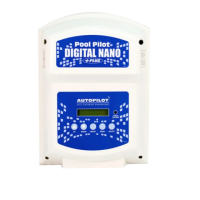Page 52
10.3 SALT ADDITION CHART
The following salt charts are included for reference only; once programmed to the correct water volume,
the controller will automatically indicate how much salt is required to achieve optimum water salinity.
The salt in the pool is constantly recycled during normal operation. Loss of salt during a swimming
season should be minimal. Filter backwashing, draining due to rain water overflow, splashing, bathing
suit drag out, and leaks are typical ways salt is lost. Salt does not leave the pool when water
evaporates.
1) Determine pool/spa volume in Gallons or Liters.
2) Find current salt level in the pool. Many pools will already have a significant salt residual, so
always test water before adding salt. (This can be obtained from the control display or by
testing water.)
3) Using Table 9, find the current salt level in the left column.
4) Determine and locate the pool/spa volume in the top column.
5) Locate the intersection of the row and column to find the amount of salt needed to bring the
pool to the ideal level.
6) For volumes other than what is shown, use combinations of various columns.
Example:
For an 11,000 gallon (41.640 Liter) pool with a salt level of 500 ppm (mg/L), the column value
for 1,000 gallons (3.786 Liter) is added to the column value for 10,000 gallons (37.854 Liter),
which gives a total of 230 pounds (104.33 kg) of salt needed to bring your pool salt level up to
the ideal level of 3,000 – 4,500 ppm (mg/L).
Table 9
Current
level of
salt
ppm
(mg/L)
Pool/Spa Volume in gallons (Liters)
Pounds (kilograms) of salt needed to attain 3000 ppm (mg/L)

